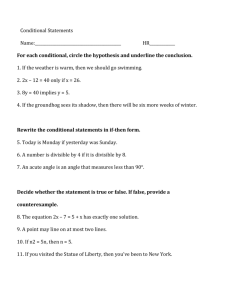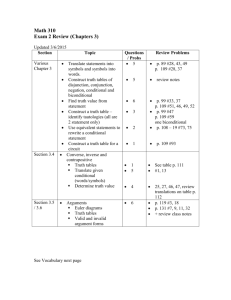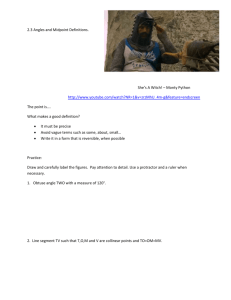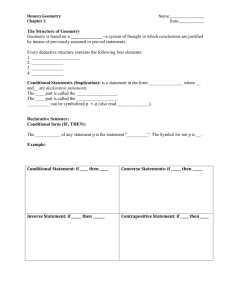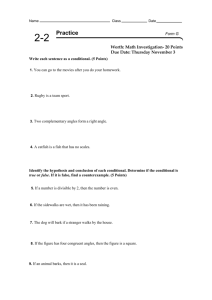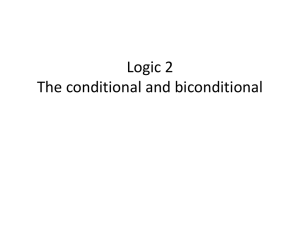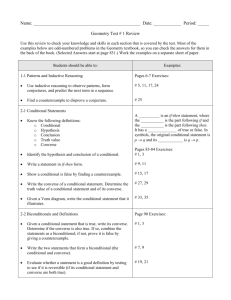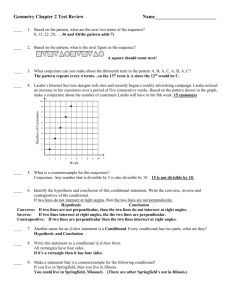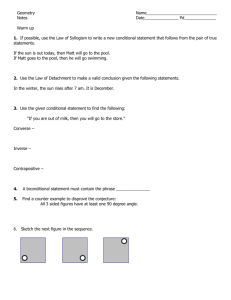MATH 20 PURE
advertisement
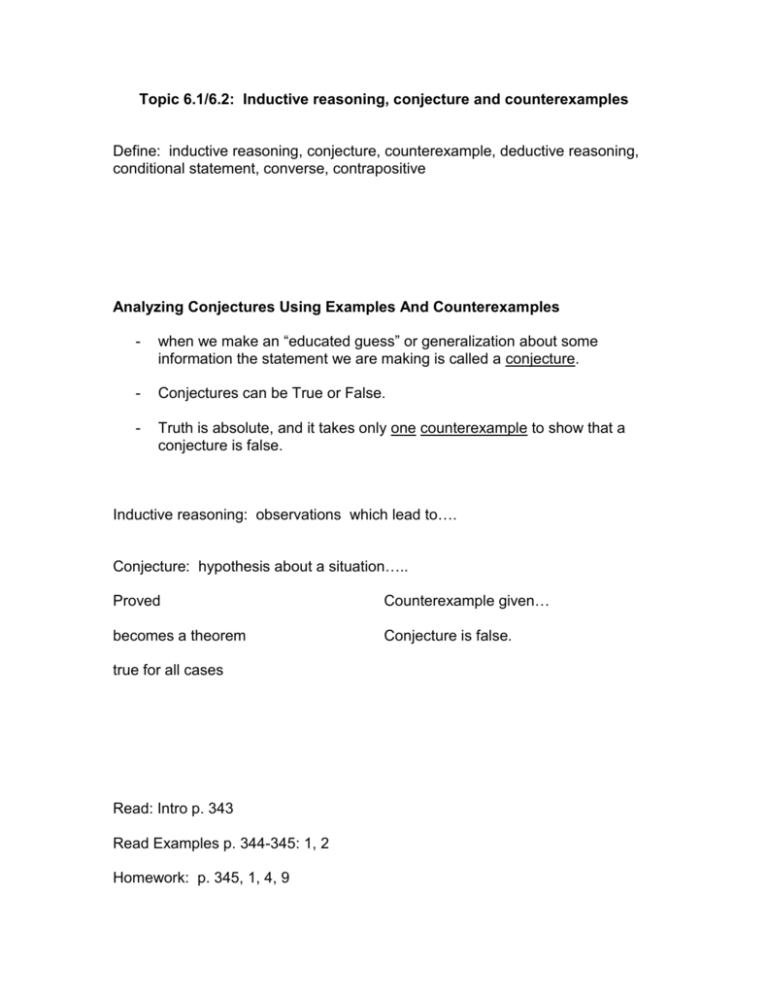
Topic 6.1/6.2: Inductive reasoning, conjecture and counterexamples
Define: inductive reasoning, conjecture, counterexample, deductive reasoning,
conditional statement, converse, contrapositive
Analyzing Conjectures Using Examples And Counterexamples
-
when we make an “educated guess” or generalization about some
information the statement we are making is called a conjecture.
-
Conjectures can be True or False.
-
Truth is absolute, and it takes only one counterexample to show that a
conjecture is false.
Inductive reasoning: observations which lead to….
Conjecture: hypothesis about a situation…..
Proved
Counterexample given…
becomes a theorem
Conjecture is false.
true for all cases
Read: Intro p. 343
Read Examples p. 344-345: 1, 2
Homework: p. 345, 1, 4, 9
Topic 6.3: Deductive Reasoning
Deductive Reasoning or logical reasoning is the process of demonstrating that if
certain statements are true, then other statements follow from them.
e.g. Today all the students received their mark for the math test. Terry was in
class today.
Conclusion statement: Terry got his mark on the math test.
e.g. Which player started the game? X or O?
Deductive Reasoning:
Inductive reasoning vs deductive reasoning
Choose a number. Double it. Add 5. Add your original number. Add 7. Divide
by 3. Subtract your original number. Repeat this with four different numbers.
Make a conjecture about the final number.
Now prove your conjecture is true for any number.
Homework: p. 349 # 1 -8, 9a, 10
Topic 6.4: Connecting Words AND, OR & NOT
A sentence that is either T or F is a statement; otherwise it is an opinion.
A Compound Statement is a statement formed by connecting one or more
statements with a connecting word such as AND, OR & NOT.
The word NOT is used to form the NEGATION of a statement.
In math, OR is always inclusive.
e.g.
x 2 x 12 factors x 4 x 3
x 4 OR x 3 are both solutions
This is not how the word is used in everyday English.
In math and everyday English AND is always INCLUSIVE.
e.g. 1 Use a number line to show n 5
means: is not greater than
n must be 5 .
e.g. 2 Use a number line to show n 3 and n 3
The number line must show where both this and that overlap .
e.g. 3 Use a number line to show n 0 and n 2
e.g. 4 Use a number line to show n 3 or n 2 .
The number line will show both regions as either can be true.
Homework: page 354 16-39, 54
Topic 6.4: Connecting Words AND, OR & NOT
e.g.1. What whole number values of x make the following compound statement
true?
x is a factor of 18 AND x is a factor of 30.
Factors of 18: 1, 2, 3, 6, 9, 18
Factors of 30: 1, 2, 3, 5, 6, 10, 15, 30
Solution {1, 2, 3, 6}
The solution can be illustrated using a Venn Diagram. You need to pay attention
to where the circles overlap showing that something belongs to more than one
group.
What values make x a factor of 18 OR a factor of 30?
Solution: {1, 2, 3, 5, 6, 9, 10, 15, 18, 30}
e.g. p. 353
Interpreting a Venn Diagram
C – families with computers
V – families with VCR
F – families with Fax
S – total families surveyed
a.
What % of families have a computer at home?
b.
How many have all 3?
7 45 62 78 /100 : 78%
5
c.
How many have none of either?
3
d.
How many do not have a fax machine?
e.
How many have computer and VCR?
f.
What fraction have computer or fax?
fax 10 so 100 10 90
62 5 67
7 62 5 4 1 79 /100 : 79%
e.g. p. 354
Drawing a Venn Diagram
Each member of a sports club plays at least one of Soccer, Rugby, or Tennis.
The following is known:
43 play Tennis
11 play Tennis and Rugby
7 play Tennis and Soccer
6 play Soccer and Rugby
84 play Rugby or Tennis
68 play Soccer or Rugby
4 play all three
How many in the Sports Club?
1.
Start in Centre
2.
AND statements next (less inclusive than OR statements)
3.
Finish Tennis Circle
4.
Complete OR statements
Homework: p. 355 – 356: 46, 51, 56, 57, 58
R 84 2 4 7 3 29 39
S 68 2 4 3 7 39 13
Sports Club members : 13 2 4 3 39 7 29 97
Topic 6.5: If, then statements, the Converse and the Contrapositive
Carefully read p. 358-359
Copy definitions & examples.
When a compound statement is written in an if…then form, it is called a
conditional statement.
e.g. If a polygon is a pentagon, then it has exactly 5 sides.
A conditional statement consists of two parts: a hypothesis and a conclusion.
The hypothesis is the part following the If.
e.g. If a polygon is a pentagon.
The conclusion is the part following “then”.
e.g. then it has exactly 5 sides.
The CONVERSE of a conditional statement is written by interchanging the order
of the hypothesis and the conclusion.
e.g. If a polygon has exactly five sides, then it is a pentagon.
When a conditional statement and its converse are both true, then can be
combined in an “if and only if” or biconditional statement.
(Definitions are always biconditional.)
Conditional Statement: If an angle is a Right Angle, then its measure is 90°.
Converse: If the measure of an angle is 90°, then it is a Right Angle.
Biconditional Statement: An angle is a Right Angle if and only if its measure is
90°.
The Contrapositive of a Conditional Statement is formed when negating the
hypothesis and conclusion of the converse of the Conditional Statement.
Contrapositive: If the measure of an angle is NOT 90°, then it is NOT a Right
Angle.
e.g. In ABC , C is 90
Write Pythagorean Theorem as a conditional statement.
Write the converse of the Pythagorean Theorem.
Write the contrapositive.
e.g. If A is acute, then A 30
Is the conditional statement true?
Write the converse and see if it is true.
Write the contrapositive. Is it true?
e.g. If x 0, then x 2 0
Is the conditional statement true?
Write the converse and see if it is true.
Write the contrapositive. Is it true?
Homework: p. 361-362; 1-27 odd, 28
